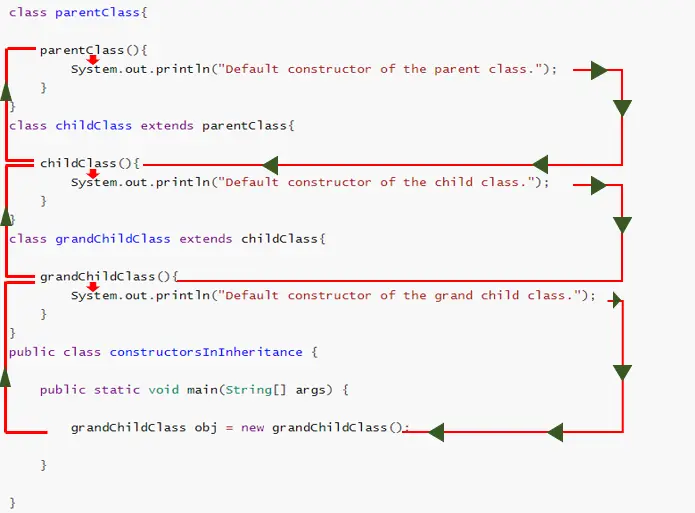在继承中执行 Java 构造函数

今天,我们将学习继承中 Java 构造函数的执行。我们将在派生类(也称为子类和子类)中看到默认构造函数和参数化构造函数的代码示例。
在继承中执行 Java 构造函数
继续这篇文章需要足够的继承知识。如果你正在阅读本教程,我们假设你对 Java 继承有深入的了解。
让我们在使用 extends 关键字扩展父类(也称为基类或超类)时了解 Java 构造函数的执行过程。
在继承中执行默认 Java 构造函数
示例代码:
class parentClass {
parentClass() {
System.out.println("Default constructor of the parent class.");
}
}
class childClass extends parentClass {
childClass() {
System.out.println("Default constructor of the child class.");
}
}
class grandChildClass extends childClass {
grandChildClass() {
System.out.println("Default constructor of the grand child class.");
}
}
public class constructorsInInheritance {
public static void main(String[] args) {
grandChildClass obj = new grandChildClass();
}
}
输出:
Default constructor of the parent class.
Default constructor of the child class.
Default constructor of the grand child class.
在这里,我们有一个名为 constructorsInInheritance 的测试类,它创建 grandChildClass 的对象。
我们还有另外三个名为 parentClass、childClass、grandChildClass 的类,其中 grandChildClass 继承 childClass 而 childClass 扩展了 parentClass。
这里,parentClass 默认构造函数由 childClass 构造函数自动调用。每当我们实例化子类时,都会自动执行父类的构造函数,然后是子类的构造函数。
观察上面给出的输出。如果仍然感到困惑,请参阅以下视觉说明。

如果我们在 main 方法中创建 childClass 的对象会怎样?现在将如何执行默认构造函数?
parentClass 的构造函数将首先执行,然后 childClass 的构造函数将产生以下结果。
输出:
Default constructor of the parent class.
Default constructor of the child class.
当父类具有默认和参数化构造函数时在继承中执行 Java 构造函数
示例代码:
class parentClass {
parentClass() {
System.out.println("Default constructor of the parent class.");
}
parentClass(String name) {
System.out.println("Hi " + name + "! It's a parameterized constructor of the parent class");
}
}
class childClass extends parentClass {
childClass() {
System.out.println("Default constructor of the child class.");
}
}
class grandChildClass extends childClass {
grandChildClass() {
System.out.println("Default constructor of the grand child class.");
}
}
public class constructorsInInheritance {
public static void main(String[] args) {
grandChildClass obj = new grandChildClass();
}
}
输出:
Default constructor of the parent class.
Default constructor of the child class.
Default constructor of the grand child class.
在这里,我们在 parentClass 中有一个参数化的构造函数。但是,仍然调用默认构造函数,因为我们在 main 方法中调用 grandChildClass() 默认构造函数,进一步调用父类默认构造函数。
我们还要在 childClass 和 grandChildClass 中编写参数化构造函数。然后,在 main 函数中调用 grandChildClass 的参数化构造函数。
观察调用了哪些构造函数,它们是默认的还是参数化的。
示例代码:
class parentClass {
parentClass() {
System.out.println("Default constructor of the parent class.");
}
parentClass(String name) {
System.out.println("Hi " + name + "! It's a parameterized constructor of the parent class");
}
}
class childClass extends parentClass {
childClass() {
System.out.println("Default constructor of the child class.");
}
childClass(String name) {
System.out.println("Hi " + name + "! It's a parameterized constructor of the child class");
}
}
class grandChildClass extends childClass {
grandChildClass() {
System.out.println("Default constructor of the grand child class.");
}
grandChildClass(String name) {
System.out.println(
"Hi " + name + "! It's a parameterized constructor of the grand child class");
}
}
public class constructorsInInheritance {
public static void main(String[] args) {
grandChildClass obj = new grandChildClass("Mehvish");
}
}
输出:
Default constructor of the parent class.
Default constructor of the child class.
Hi Mehvish! It's a parameterized constructor of the grand child class
上面的代码只调用了 grandChildClass 的参数化构造函数。我们使用 super() 调用 parentClass、childClass 和 grandChildClass 的参数化构造函数。
请记住,父类构造函数调用必须在子类构造函数的第一行。
使用 super 调用父类和所有子类的参数化构造函数
示例代码:
class parentClass {
parentClass() {
System.out.println("Default constructor of the parent class.");
}
parentClass(String name) {
System.out.println("Hi " + name + "! It's a parameterized constructor of the parent class");
}
}
class childClass extends parentClass {
childClass() {
System.out.println("Default constructor of the child class.");
}
childClass(String name) {
super(name);
System.out.println("Hi " + name + "! It's a parameterized constructor of the child class");
}
}
class grandChildClass extends childClass {
grandChildClass() {
System.out.println("Default constructor of the grand child class.");
}
grandChildClass(String name) {
super(name);
System.out.println(
"Hi " + name + "! It's a parameterized constructor of the grand child class");
}
}
public class constructorsInInheritance {
public static void main(String[] args) {
grandChildClass obj = new grandChildClass("Mehvish");
}
}
输出:
Hi Mehvish! It's a parameterized constructor of the parent class
Hi Mehvish! It's a parameterized constructor of the child class
Hi Mehvish! It's a parameterized constructor of the grand child class
我们使用 super 关键字来调用参数化的父类构造函数。它指的是父类(超类或基类)。
我们用它来访问父类的构造函数并调用父类的方法。
super 对于在父类和子类中具有确切名称的方法非常有用。
